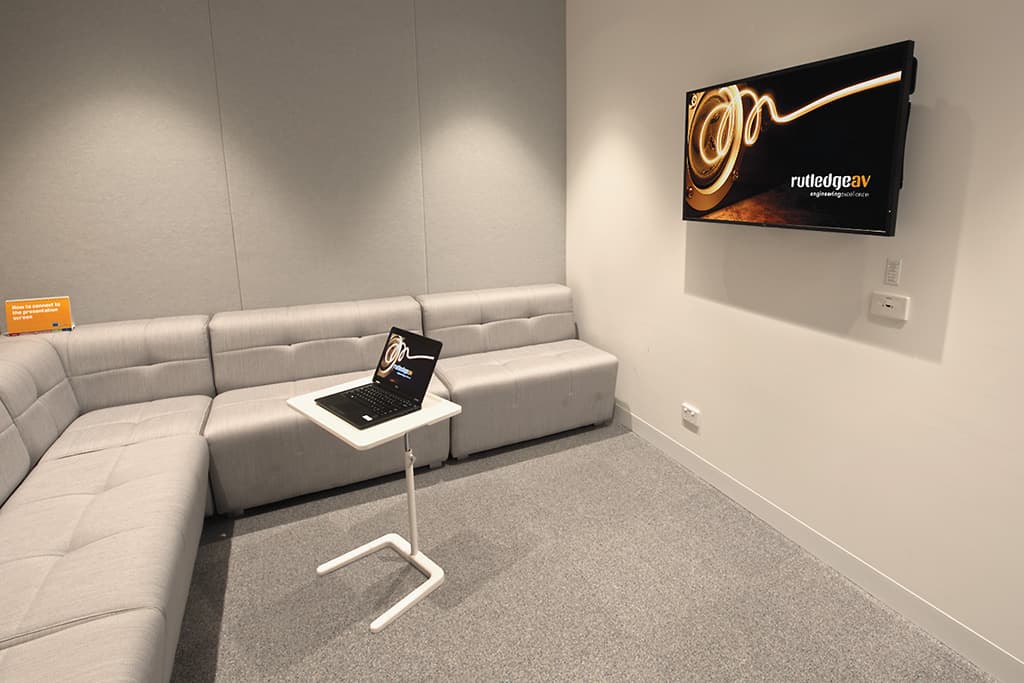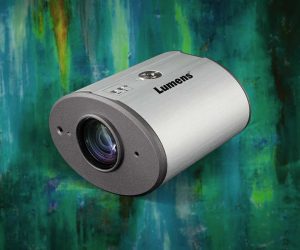
Cooking With Gas
AGL’s ABW-based HQ made for some WTF VC. Allow us to explain.
Text:/ Derek Powell
AGL’s new Melbourne office is unconventional in nearly every regard. Instead of rising from the ground, the A-grade, 6 Green Star building perches on a platform above the distinctive roofline of Melbourne’s Southern Cross station, literally leapfrogging into a prime location in the packed CBD.
Inside, the revolution continues, with AGL opting to adopt ‘Smarter Working’, an Activity Based Working (ABW) methodology, as the key design principle behind the new workplace layouts. Fixed workstations are rare in an ABW environment as most employee’s workspaces actually reside in their laptops. A mobile working environment allows employees to swiftly gather and re-group in agile, flexible and adaptable teams. However, this requirement places extraordinary demands on technology, and in particular the technology in the many and varied meeting spaces, to support seamless connection between individuals and groups.
LAPTOP LEAD
This led to an equally unconventional audiovisual design and build program as Craig Harrison, one of AGL’s key project directors and the IT lead for the new building explained: “There were three essential components in actually making ABW work. You have the people component, which is getting people ready to change and making sure that they can work in the environment; you have the spaces; and then you have the technology.”
“The technology piece was absolutely critical to making it work,” Craig elaborated. “It encompasses everything from the workstations to the laptops that people are using, then all the way through to the AV integration within that site. I did a lot of work on the desktop [environment], making sure that we could convert everyone in our business to laptops. Then we were at a decision point regarding our AV systems.”


MISSING LYNC
Craig and his team understood that communication between teams would be a critical enabler in the new team environment. A key question was creating flexible and easy to use videoconferencing spaces that integrated tightly with the new IT environment. Having adopted the Lync environment (or Skype for Business as it is now known) for instant messaging and file transfer, the team were already working on a business case to get Skype for Business telephony as well. From that standpoint a Lync solution for corporate video conferencing solutions made a lot of sense.
But there was a snag. While Lync worked just fine on laptops, there was really only one Lync room-system on the market at that point in time: the Polycom CX-8000 (and its twin, the Crestron RL).
“The challenge we had, was that it was never designed to do what we wanted it to do,” Craig Harrison recalled. “It was good, but they wanted to put a webcam up on a wall, which was never going to be adequate for a boardroom or a big meeting room — you can’t run the microphones and the cameras that you need from a small webcam sitting at the front of the room.”
With an astonishing 29 videoconference rooms planned, this technology was central and Craig knew he’d need to find a way to integrate additional devices into these machines to make them work. But at that point, the advice from VC gurus was all negative — advising him to stick with (standards based) codecs and tried and true room systems. So armed with a high-level concept, but unsure whether the integration of Lync was feasible from an audiovisual perspective, AGL went to tender with four top-flight integrators.

TAG TEAM
This is where the process really turned collaborative. AGL were seeking a partner that would work closely with their team and not just sell them into a standard solution. “It was the discussions we’d had with Rutledge AV and the ideas they were coming up with during our conversations that put them at the front, which is why we ended up appointing them,” Craig recalled.
Once appointed, the Rutledge AV specialists went straight to work to create a customised solution around the Lync-based videoconference system. Adam Crookes, Rutledge AV’s account manager for the project takes up the story.
“We worked quite closely with AGL to develop some room prototypes, using different cameras and control methodologies,” Adam noted. “At the time the CX-8000 didn’t have quite as many integration features, so we had to do some microphone/USB conversions and testing with different DSPs to come up with a reliable solution that would integrate into their wider Lync environment.
“We installed systems in Sydney and Melbourne so that we could test a wide range of cameras. We looked at the Polycom Eagle Eye cameras as well as some Logitech solutions and settled on a middle of the range Huddle Cam USB which had a PTZ functionality. Then we developed the control methodology that we had to use with the touch panel. The unit came with a specific locked-down skin that has a Lync interface. So on the back end we had to develop the basic audiovisual elements like source switching, volume control, mic mute and that sort of thing around the [existing] user interface.”
Larger spaces naturally required multiple microphones, but the traditional solution of an external DSP with per-channel echo suppression wouldn’t work in this situation as Adam recalled. “We discovered that the AEC in the DSP we tried was negated by AEC in the locked down version of the Microsoft codec. So we had to work within the limitations of the AEC of the codec itself.” After a lot of experimentation, solutions using a mix of single and multi-capsule Clock Audio button microphones with a mixer rather than a full DSP, produced a quality audio solution for each of the VC spaces.
Rutledge AV started work on the design in earnest in late 2014, and with final occupation scheduled as soon as August 2015, time was very tight. Once the videoconferencing solution was locked down the team turned their attention to the other elements demanded by the Activity Based Workplace.


MORE THAN VC
As well as the videoconference spaces, there were more than a hundred meeting rooms, huddle and collaboration spaces and training centres, each requiring presentation capabilities that were effective, yet simple to use. Craig’s team at AGL made an early decision to go for wireless connections where possible and set out to trial a number of products before settling on Crestron’s AirMedia.
“There were a lot of products out in the market place that had full collaboration suites built in to them,” Craig recalled. “But we were really strict on the fact that we had Lync as our Collaboration Suite. So what we needed was a product that would allow us simply to present, if we wanted to do collaboration, screen sharing or electronic white-boarding or anything like that, we would do that through Lync.”
With key decisions on videoconferencing equipment and wireless connectivity out of the way, Rutledge AV moved quickly to the detailed design. To Adam Crookes the logical next step was to decide on a control solution. “We looked at coalescing everything under a single Crestron banner,” he recalled. “This allowed us to leverage Fusion [Crestron’s Remote Asset Management solution] to create a holistic solution.”
Overlaid on the room-based presentation systems is a requirement for effective digital signage that could provide corporate communication, wayfinding and the ability to broadcast ‘town hall’ meetings and messages company-wide. Rutledge AV suggested that an IPTV system would be very effective in the live broadcast role as well as allowing for free-to-air television distribution throughout the building. More than 40 spaces were ultimately equipped as IPTV end-points and the 300-seat function space on the top floor is just one of the areas equipped for recording and live broadcasting across the system.
TWO FLOORS AT A TIME
The sheer scale of the installation became obvious when final installation started in earnest. Two floors at a time were handed over by the builder and the Rutledge AV team had just two weeks to complete eight videoconference rooms, 10 – 15 meeting spaces and a slew of digital signage and IPTV installations before the AGL staff moved in. Then it was straight into the next pair of floors, and two weeks after that, the next.
It was a huge logistical task and Rutledge AV mobilised multiple teams to keep pace with the demanding schedule. “On-site at the peak,” Adam remembers, “we had 10 site installation technicians, four commissioners, two programmers, a site supervisor, the project manager and myself as the account manager.”
The rest, as they say is history. Both AGL and Rutledge AV are very satisfied with the partnership model, and the results achieved. From AGL’s viewpoint Craig Harrison observed that despite the challenging time-frame, the process produced a very satisfying outcome.
“It did work very well”, he said. “With Adam and his team, I think Rutledge AV identified the best people to align with us. For me personally, I think the difference between putting a TV screen on a pole (or on a wall) versus putting in an AV system – is making sure that the business and the partner are working very closely together.”
EQUIPMENT HIGHLIGHTS
- 33 x Polycom CX8000
- 34 x Huddlecam HD
- ~230 NEC Displays
- NEC & Epson projectors
- Crestron Fusion Remote Asset Management
- Crestron AirMedia
- Extron HDMI extenders
- Biamp TesiraForte DSP with AEC
- Extron HDMI Audio De-Embedders
- Clock Audio Desktop Mics
- Shure ULXD Wireless Microphone Systems
- Tannoy CVS6 In-Ceiling Speakers
- Bosch EVID Ceiling Speakers
- Lab.Gruppen Power Amps
- Extron 100V Line Amps
- Williams Sound Infrared Hearing Assist
- Lectrum lectern















RESPONSES